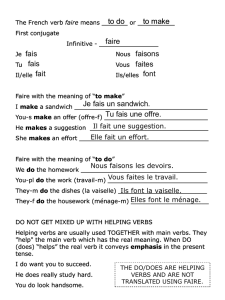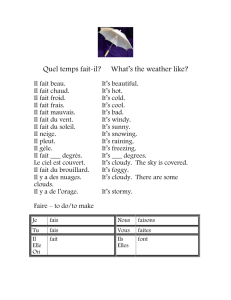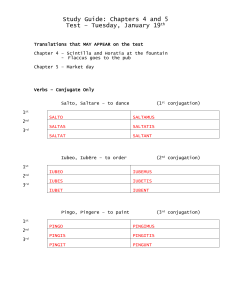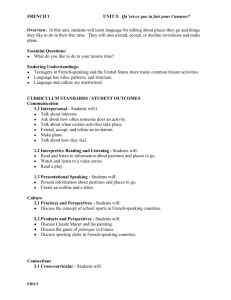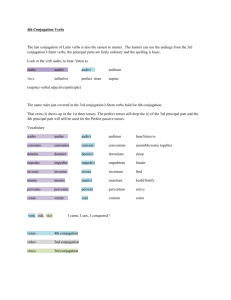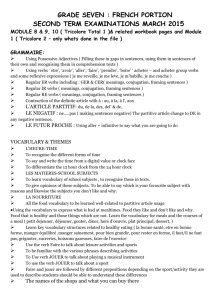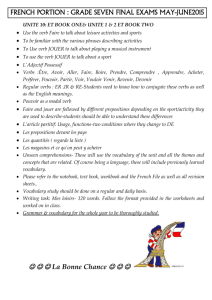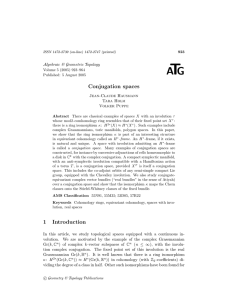SS11 days months seasons weather - WCL
advertisement
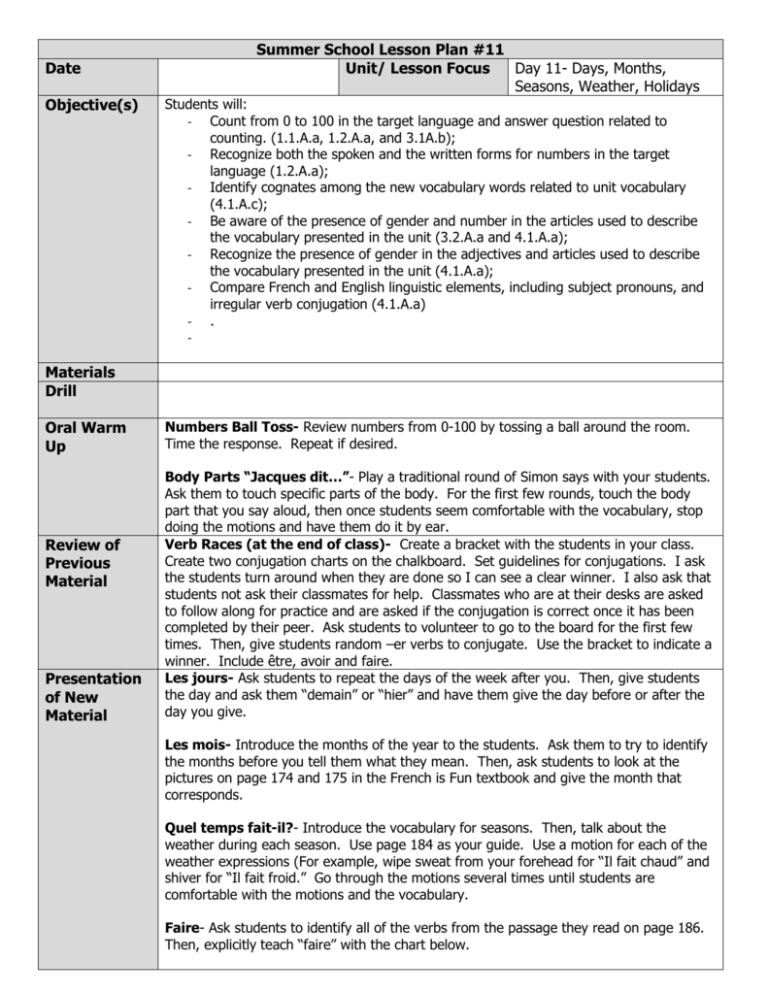
Date Objective(s) Summer School Lesson Plan #11 Unit/ Lesson Focus Day 11- Days, Months, Seasons, Weather, Holidays Students will: - Count from 0 to 100 in the target language and answer question related to counting. (1.1.A.a, 1.2.A.a, and 3.1A.b); - Recognize both the spoken and the written forms for numbers in the target language (1.2.A.a); - Identify cognates among the new vocabulary words related to unit vocabulary (4.1.A.c); - Be aware of the presence of gender and number in the articles used to describe the vocabulary presented in the unit (3.2.A.a and 4.1.A.a); - Recognize the presence of gender in the adjectives and articles used to describe the vocabulary presented in the unit (4.1.A.a); - Compare French and English linguistic elements, including subject pronouns, and irregular verb conjugation (4.1.A.a) - . - Materials Drill Oral Warm Up Review of Previous Material Presentation of New Material Numbers Ball Toss- Review numbers from 0-100 by tossing a ball around the room. Time the response. Repeat if desired. Body Parts “Jacques dit…”- Play a traditional round of Simon says with your students. Ask them to touch specific parts of the body. For the first few rounds, touch the body part that you say aloud, then once students seem comfortable with the vocabulary, stop doing the motions and have them do it by ear. Verb Races (at the end of class)- Create a bracket with the students in your class. Create two conjugation charts on the chalkboard. Set guidelines for conjugations. I ask the students turn around when they are done so I can see a clear winner. I also ask that students not ask their classmates for help. Classmates who are at their desks are asked to follow along for practice and are asked if the conjugation is correct once it has been completed by their peer. Ask students to volunteer to go to the board for the first few times. Then, give students random –er verbs to conjugate. Use the bracket to indicate a winner. Include être, avoir and faire. Les jours- Ask students to repeat the days of the week after you. Then, give students the day and ask them “demain” or “hier” and have them give the day before or after the day you give. Les mois- Introduce the months of the year to the students. Ask them to try to identify the months before you tell them what they mean. Then, ask students to look at the pictures on page 174 and 175 in the French is Fun textbook and give the month that corresponds. Quel temps fait-il?- Introduce the vocabulary for seasons. Then, talk about the weather during each season. Use page 184 as your guide. Use a motion for each of the weather expressions (For example, wipe sweat from your forehead for “Il fait chaud” and shiver for “Il fait froid.” Go through the motions several times until students are comfortable with the motions and the vocabulary. Faire- Ask students to identify all of the verbs from the passage they read on page 186. Then, explicitly teach “faire” with the chart below. Development al Activities Subject Pronoun Conjugation Subject Pronoun Conjugation Je fais Nous faisons Tu fais Vous faîtes Il/Elle/On fait Ils/Elles font Qu’est-ce que tu fais?- Ask students to work with a partner and find out what they do on each day of the week. Use activities vocabulary. Use the Conversation on page 180 as a model. Les Anniversaires- Ask students to ask their classmates “Quel est ton anniversaire?” and write down the date and month. Then, create a master list of birthdays (without names) on the chalkboard. Call out a birthday in French and ask students to write who it belongs to on their whiteboards. Written Activities- Ask students to complete the written activities in the French is Fun text. Activity C on page 171, Activities O and P on page 178. Seasons, Months, Weather Graphic Organizer- Ask students to fold their paper into a hamburger and a hotdog (4 boxes). Then have them label each box a season. Ask them to write the months that correspond with each season and the weather that is appropriate. You may also ask them to draw a visual representation of each weather expression. Reading w/Faire- Ask students to look at the reading on page 186. Ask them to work with a partner to summarize the selection and identify all of the verbs in the passage. Then, ask them to complete the sentences in Activity E on page 187. Use this activity as a lead into teaching the irregular verb faire. Conjugating Faire- Ask students to complete Activities I, J and K on page 189 in the French is Fun text. Share, Reflection, and Assessment Jacques dit…- Use the kinesthetic vocabulary to review body parts and express weather with your students. Ask students to share their answers to the written activities. Modifications and Accommodation s State Curriculum Indicator(s) Students engage in brief exchanges about personal interests in the target language. (1.1.A) Students understand spoken and written language on very familiar topics in the target language that promote the learning of basic linguistic structures. (1.2.A) Students make short presentations and write simple communications on very familiar topics in the target language.(1.3.A) Students identify and describe practices and perspectives of the cultures studied. (2.1.A) Students identify and describe the products within the cultures studied. (2.2.A) Students access new information and reinforce existing knowledge of other content areas through the target language. (3.1.A) Students examine various topics from the perspectives of cultures where the language is spoken. (3.2.A) Students gain insight into the nature of English by comparing how a different language system expresses meaning and reflects culture. (4.1.A) Students identify and compare the products, practices, and perspectives from the Notes/ Reflection target cultures to their own. (4.2.A) Students use and extend their language proficiency and cultural knowledge through face-to-face encounters and/or the use of technology both within and beyond the school setting. (5.1.A) Students explore opportunities to use the target language both at home and abroad while accessing a wide variety of resources where students can pursue topics of personal interest. (5.2.A) What went well? Did the students accomplish the objective? What would I do differently?
